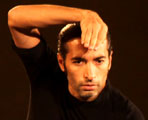Sunday, September 9th, 2012. 11:00pm. Monasterio de la Cartuja
Special 17th Bienal de Flamenco de Sevilla – All the information
Text: Estela Zatania
Photos: La Bienal
Israel’s existential nudity
Israel Galván’s works have for years been evolving towards the reduction or elimination of elements and structures. Last night, with “Solo”, the artist achieved the maximum of the minimum. For 40 minutes he moved about the stage…alone, “solo”, the very title of the work is the libretto…without music or percussion or staging or any other sort of accompaniment. Dressed in black, he interpreted a single piece not quite 40 minutes long, non-stop, with no beginnings or endings. The only way to reach greater simplicity would be to omit clothing like India’s holy men.
When you think of it, some oriental philosophy seems to be behind the work of Israel Galván. Beginning with the concept that we must fight the impulse to “turn nouns into verbs”, even though dancing is exactly the opposite: the expression of ideas or emotions (nouns) via movement (verbs).
It’s that Galván’s “shows”…notice how it seems necessary to use shock quotes around that word…are mental exercises, like Buddhist conundrums that stimulate meditation. You go to his performances, not to be entertained, but to become intellectually enriched and test your capacity to assimilate the meaning of his message. It’s not always easy.
Galván says that in this work he dances to his own compás, “the internal rhythm is always there”. This is far more radical than dancing without music to the compás we all share in our minds and which hangs in the air. It’s making a break with compás as we’ve known it until now, and demanding absolute freedom for the interpreter. Sounds perfect…all artists must enjoy complete creative freedom. Or what? Perhaps the very act of dancing can be defined as a full-body response to the external stimulus of a rhythm, music or voice. But Israel doesn’t want to dialogue. He demands such complete freedom that only a monologue will do for him.
The artiste arrived in silence and darkness, walking slowly. At that precise moment, as if on cue, a night-owl or similar made that haunting sound they make, again and again throughout the brief show, daring to provide the accompaniment Israel had chosen to eschew. Any other maestro would have been received at the beginning of a show with applause. But somehow we all knew the superficiality of an ovation would be out of place, and there was complete silence among the 300 people that filled all the seats of the patio of the Centro Andaluz de Arte Contemporáneo.
Israel seems extremely thin but strong. It’s a look that complements his conceptual style. There’s not much to say about what went on during those 40 minutes. The typical Galvanic poses with many new ones that reveal much investigation. And I ask myself: isn’t this kind of soul-searching best carried out in the privacy of a studio? Suddenly he seduces you with a brief fragment of compás, but it immediately vanishes. Or a single line of cante with his own voice but which goes unfinished. Tiny squeals and assorted noises, percussion upon feet, abdomen, teeth…
In my opinion, and it’s nothing more than that, an opinion, Israel Galván is so concerned with the form, he ignores the essence. To be sure, any dancer who would move around a stage with no stimulus other than silence, would bore spectators. In that sense, thanks to his extraordinary imagination and technical ability, Galván is much less boring than others. They always say that the bare-bones minimum to make flamenco vibes among a group of people is a flamenco singer. Not a guitar alone or dance alone…they say. Our man seems determined to challenge that concept, but it’s not clear if he achieves that goal.
The problem with monologues is that the observer can observe, but never partake because no common ground is set out where you can admire how well it is travelled by the interpreter. “Solo” is not flamenco by any conventional definition, it would be naïve to insist that it is. But then neither were the kathak dancers the other day, nor other diverse elements that have been incorporated in this Bienal de…Flamenco.
